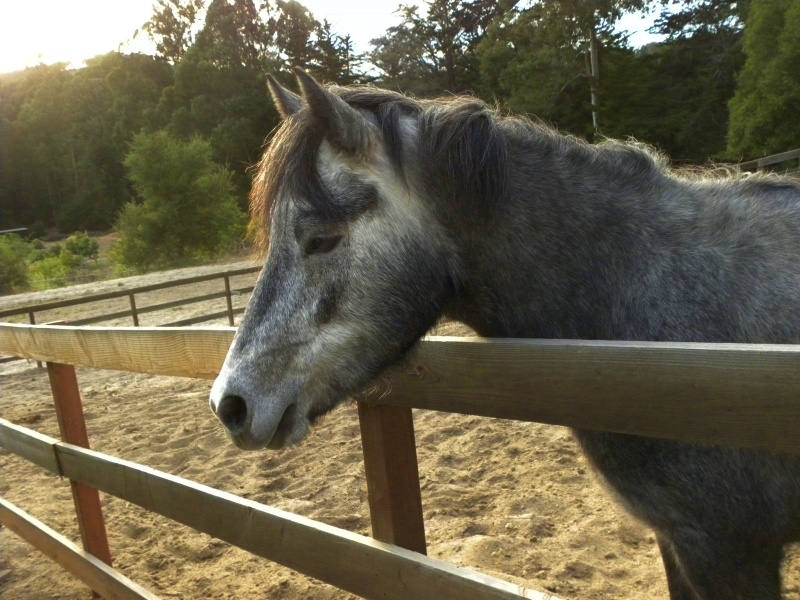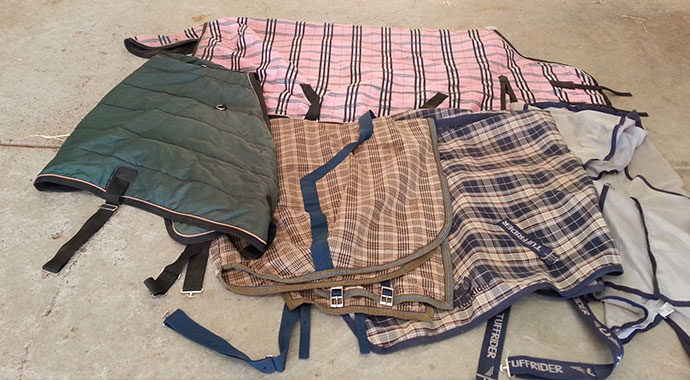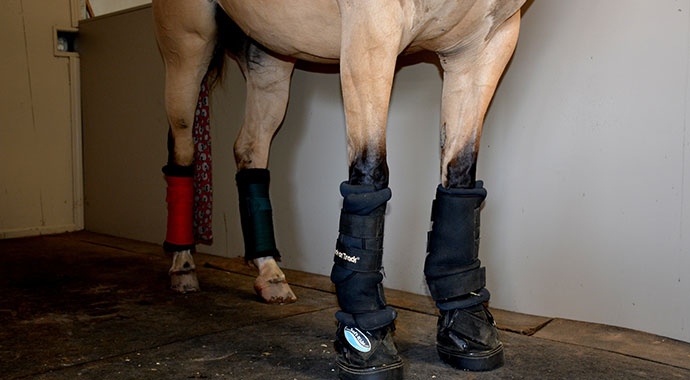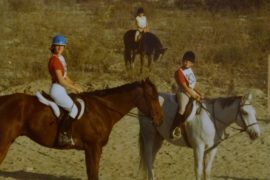Falling wet drops triggered an immediate beg from my Connemara/TB mare for her winter horse blanket. The sound of a metal horse shoe sliding and banging on the horizontal metal gate pole, simply could not be ignored. Fortunately, living just around the corner enabled me to be at her beck-and-call. I could manage my horse’s winter blanket in a timely manner.
Once the begged-for waterproof blanket was draped over her back, she was satisfied. Thus began the twice a day trek to the barn to manage my horse’s winter blanket. I never body clipped her and she didn’t grow a super fuzzy winter coat. Yet, to her, wet and cold weather was something to be endured and covering her with a blanket made it easier for her. I was happy to oblige.
To Blanket or Not to Blanket? That is the Question
My mare made the winter horse blanket question easy for me to answer. However, many horse owners wonder about whether or not to blanket in winter. Some laugh at horse owners in temperate climates who decide to make managing their horse’s winter blanket a daily routine. Could there actually be more to the question?
Myths and Facts About a Horse’s Winter Coat and Blanketing
Are you prepared to leave your animals with a pet sitter? Help communicate all the vital care instructions with a Horse and Pet Care Communication Checklist.
What factors trigger the appearance and disappearance and degree of thickness of a horse’s winter coat?
Photoperiod: The daily photoperiod influences the horse’s hair growth the most. Shorter daily photoperiods indicate colder weather is approaching, and the winter coat comes in. The most impactful shorter days begin in September when you’ll notice your horse’s summer coat shedding out, and the fuzzy approach of the winter coat coming in. Winter Solstice, the shortest day of the year, comes at the end of December. So, come March your horse is in full shedding season mode as the daily photoperiod increases from Winter Solstice.
Climate: Yes, the environment does play a role. Horses in warmer climates grow a lighter winter coat compared to horses in northern and consistently cold winter climates. Therefore, modifying a horse’s winter coat might be influenced by keeping the horse warm by blanketing early.
Genetics: Some horses naturally have thicker coats than others. Ponies in particular tend to ‘suit up’ well for winter. My Connemara Pony filly is quite fluffy now, in contrast to her stablemates who are mostly “Rockies”.
Does blanketing minimize a horse’s winter coat?
This management practice, of blanketing a horse, is used by horse owners in order to minimize the winter hair growth. Can it be effective?
I took this question to one of our local veterinarians, Dr. Emily Bardo of The Equine Center. Does blanketing a horse minimize its winter coat?
Dr. Bardo replied, “It’s complicated, but if you want a slick ‘show-coat’ or will be riding your horse quite a bit during the winter it is better to consider keeping your horse under lights or body clipping to control coat length. Simply blanketing a horse will not affect the coat length to a large degree. Horses in the more temperate climate of California versus colder climates (like for example Montana) will grow different kinds of winter hair coats in response their environment. As you might expect the horse’s body does take into account if it needs a big thick coat for 20-degree temperatures and snowstorms, or a thinner coat for high 60’s and occasional rain.
You can try and trick the horse’s body a little bit by blanketing, but all horses will grow a winter coat regardless due to the change in the photoperiod. As the days get shorter the horse’s brain signals to the body that it needs to grow a longer and denser hair coat. For our area this process usually starts in early September. If you want to try and influence your horse’s coat length, that is the time to start putting the horse under lights or blanketing at night.”
Hey, head’s up. Clicking the the links or product pics that follow may result in providing us a little kick-back money. To learn more see the affiliate disclaimer at the end of this story.
Can blanketing a wet horse make it sick?
Many riders are working their horses in the late afternoon to early evening and face managing a wet and worked horse. Is blanketing a horse in this condition OK? Sometimes life keeps us from blanketing our horses before a rain storm. We then face the reality of covering a wet horse.
What is the best course of action?
Again, I asked Dr. Emily Bardo. She provides this information, “It is best to blanket a horse when the horse is dry. If you blanket a horse when it is still wet you are creating a warm and moist environment on the skin surface. This kind of environment is conducive to an overgrowth of bacteria or fungus, and can cause skin disease such as ring worm or dermatophilosis also known as ‘rain rot’.
If you do have to blanket a wet horse, try and get the coat as dry as possible with towels first. You can also use an antibacterial/antifungal spray like 2% chlorhexidine, to be sprayed onto the moist hair prior to blanketing to help manage fungus or bacteria. It is also a good idea to have at least two waterproof blankets so you can switch out a very wet blanket with a clean and dry one during heavy rainstorms.”
How should a horse’s winter blanket wearing be managed?
Once you start blanketing, it is best to continue through the cold winter months. One must consider how a horse manages heat before cold. A blanketed horse in high temps cannot easily cool themselves, since they can’t take their jacket off. Therefore, it is very important to remove your horse’s winter blanket during the warm and sunny daytime.
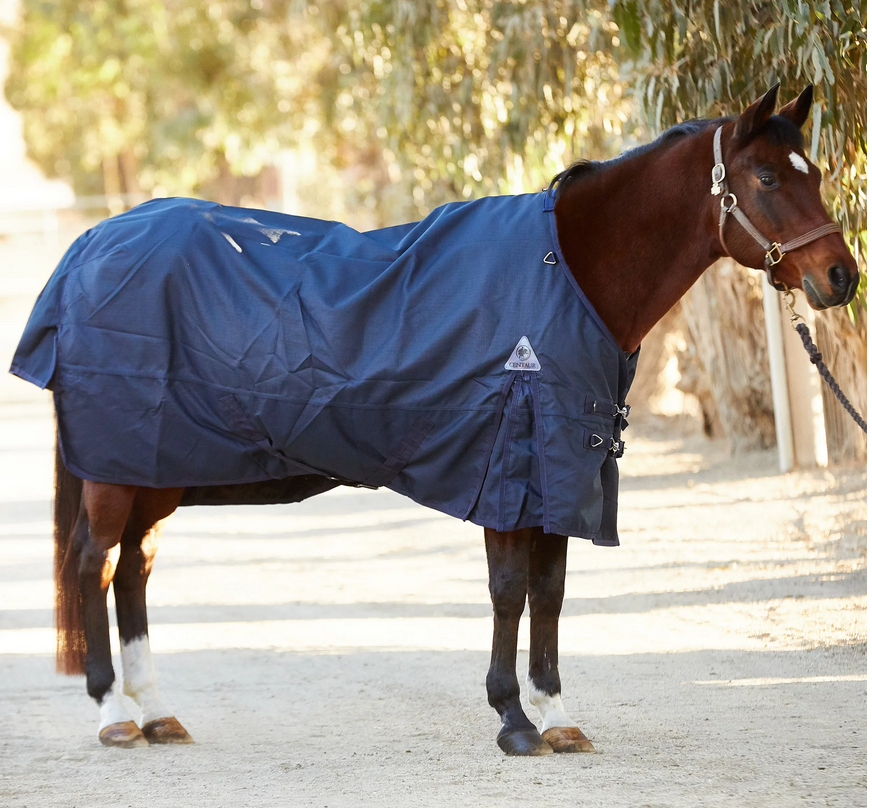
Certain conditions up the demand for blanketing a horse in the winter. These conditions are: A clipped horse, an elder horse, one in poor body condition and one with no shelter. Windy and rainy weather is harder on a horse than snow. Rain mats and wets down the hair coat while decreasing the vital airflow needed for regulating the horse’s body temperature. Snow, although colder, tends to rest on top of the coat, even providing a form of insulation. Therefore, even unclipped horses in temperate yet wet winter conditions may benefit from a simple rain sheet or light waterproof blanket.
Is the condition of the blanket important?
What condition is your horse’s winter blanket in? One that has lost its waterproofing, or is torn or ripped or doesn’t fit right will not provide the horse much help. Dr. Bardo weighs in on this factor, “At this point in the year it is a good time to be pulling out all of your blankets to check that they are clean, waterproof, and don’t need any repairs.” If your horse needs a new winter horse blanket, check out this this story: Let it Rain: Smart Horse Blanket Options for a Wet Winter.
To Blanket or Not to Blanket on the California Central Coast?
Dr. Bardo summarizes the answer here: “Most of our horses on the Central Coast will do just fine without a blanket as long as they have some sort of shelter structure to get out of the rain and wind. Older horses or horses with medical conditions may need some extra assistance staying warm, and blanketing should be considered. Also, if we are going to get a lot of rain, especially with cold temperatures or strong winds it is not a bad idea to blanket (even just a simple rain sheet) to keep their coat dry so they can retain body heat better.
If you have body clipped your horse, or if the horse has a thin show coat and has been under lights the horse will definitely need a blanket to stay warm and comfortable. A good rule of thumb for those who like to blanket at night regardless: if temperatures are getting down below 40 degrees go ahead and blanket.”
Just so you know, clicking the above pictures and product links takes you to the product on the Riding Warehouse and Amazon websites. This makes shopping easy and convenient for you. We do get a little kick-back from items purchased, giving us resources to bring you more stories, but your price stays the same. It’s a win-win! Also for local riders, sometimes you can order items online and request pick-up – during checkout – at the Riding Warehouse store in San Luis Obispo. Happy Trails!
Product photo courtesy of Riding Warehouse.
Photo credit: Sharon Jantzen Photos
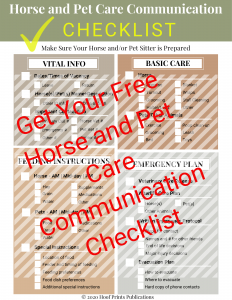
Are you prepared to leave your animals in the care of a pet sitter? The Horse and Pet Care Communication Checklist enables you to gather all the vital information you need to communicate all the elements of all your animals’ care to your pet sitter. What if you suddenly had to leave town? Would you be ready for someone to quickly step in and take care of your animals? What if something happened to your horse or pet while you were away? Would your pet sitter know your wishes? This checklist will help you prepare your pet sitter to care for your animals the way you do. Get your Horse and Pet Care Free Checklist here >.

